Click on images to enlarge

habit in summer (Photo: Trevor James)

habit with flowers in early spring (Photo: Rob and Fiona Richardson)

multiple trunks on mature plant (Photo: Rob and Fiona Richardson)

close-up of hairy younger stems with young winter buds (Photo: Greg Jordan)
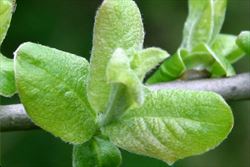
close-up of young leaves in spring (Photo: Trevor James)
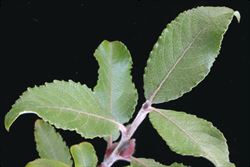
relatively broad leaves (Photo: Greg Jordan)
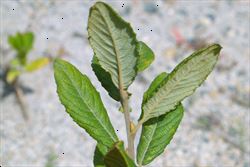
upper and lower surfaces of older leaves (Photo: Trevor James)

winter buds and young flower clusters (Photo: Rob and Fiona Richardson)

male flower clusters (Photo: Trevor James)

close-up of male flowers (Photo: Trevor James)

female flower clusters (Photo: Trevor James)
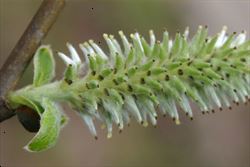
close-up of female flowers (Photo: Trevor James)
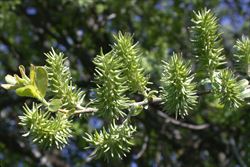
immature fruit (Photo: Rob and Fiona Richardson)

close-up of immature fruit (Photo: Trevor James)
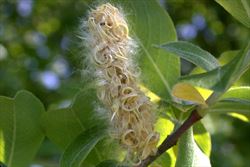
mature fruit releasing their seeds (Photo: Rob and Fiona Richardson)

close-up of seeds with silky hairs (Photo: Rob and Fiona Richardson)
Scientific Name
Salix cinerea L.
Synonyms
Salix atrocinerea Brot.
Salix caprea L. (misapplied)
Salix cinerea L. subsp. cinerea
Salix cinerea L. subsp. oleifolia (Sm.) Macreight
Family
Salicaceae
Common Names
common sallow, gray sallow, gray willow, grey sallow, grey willow, grey-leaved sallow, large gray willow, pussy willow, rusty sallow
Origin
Native to most of Europe, Russia and western Asia (i.e. Turkey, Azerbaijan and Kazakhstan).
Cultivation
Grey sallow (Salix cinerea) has been widely planted around waterbodies and along waterways in the temperate regions of Australia, mainly to prevent soil erosion.
Naturalised Distribution
Widely naturalised in south-eastern Australia (i.e. in many parts of eastern New South Wales, in the ACT, in Victoria and Tasmania, and in south-eastern South Australia). Also sparingly naturalised in the sub-coastal districts of south-eastern Queensland.
Naturalised overseas in North America (i.e. eastern Canada and eastern USA) and New Zealand.
Habitat
A weed of waterways, riparian vegetation, lake edges, billabongs, swamps and wetlands in wetter temperate regions.
Habit
A shrub or small spreading tree usually growing up to 8 m tall, but occasionally reaching up to 12 m tall. It produces many upright (i.e. erect) branching stems from near ground level.
Distinguishing Features
-
a shrub or small spreading tree, with multiple stems, that loses it leaves during winter.
-
its younger stems are green, greenish-brown or dark reddish-brown in colour and either hairy or virtually hairless.
-
its alternately arranged leaves (3-9 cm long and 1.5-4 cm wide) are relatively broad with entire to finely toothed margins.
-
separate male and female flowers are borne on separate plants, usually before the new leaves in spring.
-
both types of flowers lack any petals or sepals and are borne in elongated clusters in the upper leaf forks.
-
its small capsules (up to 10 mm long) contain tiny seeds topped with a tuft of silky hairs.
Stems and Leaves
The bark on the stems is smooth and greyish-brown in colour, but eventually becomes fissured with age. Younger stems are green, greenish-brown or dark reddish-brown in colour and may be hairy (i.e. pubescent) or virtually hairless (i.e. sub-glabrous).
The alternately arranged leaves are borne on short stalks (i.e. petioles) 2-5 mm long. These leaves (3-9 cm long and 1.5-4 cm wide) are oval (i.e. elliptic) or egg-shaped in outline (i.e. obovate) with entire to finely toothed (i.e. serrulate) margins and shortly-pointed tips (i.e. acute apices). Their upper surfaces are bright green and sparsely hairy (i.e. sparsely pubescent), while their undersides are pale green or bluish-green (i.e. glaucous) and more densely hairy (i.e. densely pubescent).
Flowers and Fruit
Separate male and female flowers are usually borne on separate plants (i.e. this species is dioecious), but may sometimes be present on different parts of the same plant (i.e. rarely monoecious). Both types of flowers are inconspicuous and are densely arranged in stalkless clusters (i.e. sessile catkins) in the upper leaf forks (i.e. axils). They do not have any sepals or petals, but each flower is subtended by a small bract. The male (i.e. staminate) flowers are green or greenish-yellow in colour and borne in relatively short clusters (2-3 cm long and about 2 cm across). They are about 10 mm long and consist of two or more yellow stamens. The female (i.e. pistillate) flowers are mostly green in colour and are usually borne in slightly longer clusters (2-4 cm long). They consist of an ovary topped with a stigma. Flowers are produced before the new leaves in early spring.
The fruit is a small hairy capsule (up to 10 mm long) containing tiny seeds. These seeds, which are topped with a tuft of silky hairs, are shed about four weeks after flowering.
Reproduction and Dispersal
This species reproduces by seed and vegetatively via the rooting of detached twigs or branches.
The light and fluffy seeds are easily dispersed by wind and water, while twigs and branches may be spread during floods, by machinery, during removal, and in dumped garden waste.
Environmental Impact
Grey sallow (Salix cinerea) is regarded as a significant environmental weed in Victoria, and as an environmental weed in the ACT, Tasmania and New South Wales. It is one of the willows that, as a group, are regarded as a Weed of National Significance (WoNS). These species are primarily of concern along waterways, in wetlands and around other waterbodies. They compete strongly for space, water and nutrients, eventually displacing the native vegetation in the habitats they invade.
Unlike many of the other willows, grey sallow (Salix cinerea) also invades other habitats away from water, including heathlands, heathy woodlands, alpine and sub-alpine vegetation, the understorey or mature pine plantations.
For more on the environmental impact of willows (Salix spp.) in Australia, see Victorian Department of Sustainability and Environment Landcare Note entitled "Willows along watercourses: their impact compared to natives", which is avialable online at http://www.dpi.vic.gov.au.
Legislation
This species is declared under legislation in the following states and territories:
- ACT: C2 - a pest plant that must be suppressed, and C4 - prohibited pest plant (a pest plant whose propagation and supply is prohibited).
- New South Wales: Class 3 - a regionally controlled weed. The relevant local control authority must be promptly notified of the presence of this weed and it must be fully and continuously suppressed and destroyed (in the Blue Mountains local authority area only), and Class 5 - a restricted weed which must not be sold, bought or knowingly distributed (throughout the entire state).
- Northern Territory: A - to be eradicated (throughout all of the Territory) and, C - not to be introduced into the Territory.
- Queensland: Class 1 - introduction into the state is prohibited, and landowners must take reasonable steps to keep land free of this species (throughout the entire state). It is also illegal to sell a declared plant or its seed in this state.
- South Australia: 11+ - Class 11 is a category for those species that are 'Weeds of National Significance' but are not otherwise declared in South Australia. Control of this species is not currently required, but its sale is restricted throughout the state.
- Tasmania: D - the importation or sale of this species is prohibited and measures to reduce its population in an area, eradicate it from an area, or restrict it to a particular area may be required.
- Victoria: R - a restricted weed that cannot be sold or traded in this state.
- Western Australia: P1 - trade, sale or movement into the state prevented, and P2 - to be eradicated (throughout the entire state).
Management
For information on the management of this species see the following resources:
- a wide variety of resources, including the National Management Guide for Willows, is available online at http://www.weeds.org.au/WoNS/willows/.
- the Victorian Department of Sustainability and Environment Landcare Note entitled "Willows along watercourses:
managing, removing and replacing", which is available online at http://www.dse.vic.gov.au.
- the Greening Australia Willow Control fact sheet, which is available online at http://www.greeningaustralia.org.au.
Similar Species
Two forms of Salix cinerea are present in Australia (i.e. Salix cinerea subsp. cinerea and Salix cinerea subsp. oleifera), but these are not always recognised as being separate entities. They can be distinguished from each other by the followng differences:
- grey sallow (Salix cinerea subsp. cinerea) has green or greenish-brown coloured younger twigs that are often hairy (i.e. pubescent).
- rusty sallow (Salix cinerea subsp. oleifera) has dark reddish-brown coloured younger twigs that are virtually hairless (i.e. sub-glabrous).
Grey sallow (Salix cinerea) is also confused with some of the other willows (Salix spp.) with shrubby habits, and hybrids between this and other species can be extremely difficult to separate from each other. To distinguish between these, see one of the texts specifically developed for the identification of willows (Salix spp.) in Australia:
- the Victorian Department of Sustainability and Environment Willow Identification Guide, which is available online at http://www.dpi.vic.gov.au.
- the Weeds of National Significance Willow Identification resource sheet, which is available online at http://www.weeds.org.au/WoNS/willows/docs/Willow_identification-Resource_Sheet2.pdf.
- the Key to Willows (Salix) in Rural Australia, which is available online at http://www.hoadley.net/cremer/willows/docs/key2.DOC.

